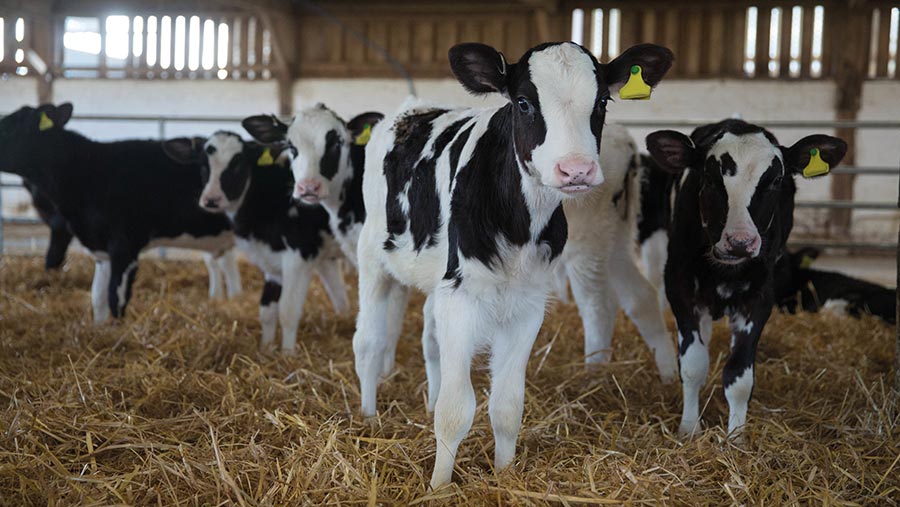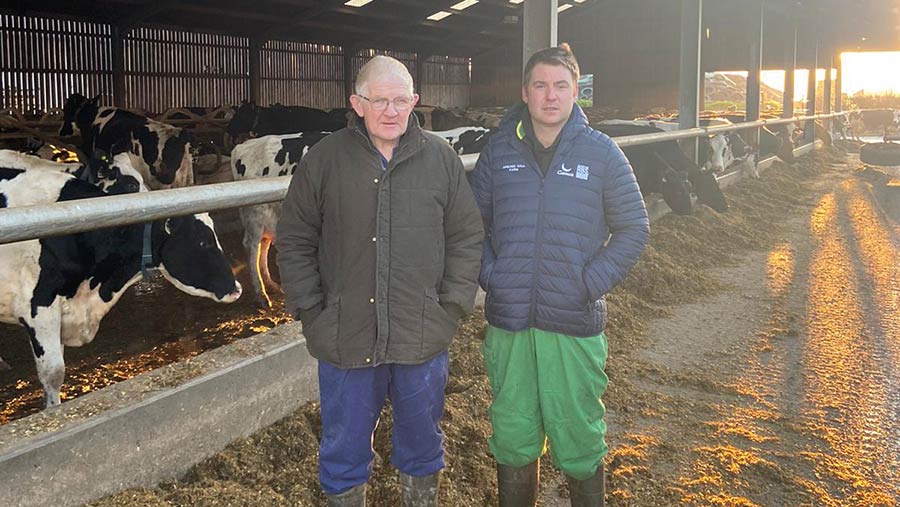How genomic testing of heifers can improve profitability
 © Tim Scrivener
© Tim Scrivener Genomic testing replacement heifers has a cost benefit of £19.39 a heifer, according to a three-year study involving nine Welsh dairy farms.
The project compared the difference between estimated breeding values based on parent averages – a composite of a heifer’s family pedigree – and genomic predicted transmitting ability (PTA). Genomic PTA provides information early on in a heifer’s life to allow breeding decisions to be made before rearing costs are incurred.
See also: 6 tips on using genomics in your dairy herd
Genomic testing is now 60-70% reliable for predicting future performance, compared with just 35% for parent averages, but testing adds an extra £25-£30 to rearing costs.
The European Innovation Partnership (EIP) study, which involved 432 Holstein Friesian heifers, weighed up this cost against the benefits. It calculated a cost benefit of £19.39 for each heifer (the total economic benefit of £46.89 an animal minus the test cost of £27.50 a head).
However, Victoria Hicks, of Kite Consulting, who analysed the results, says the cost benefit figure does not include any cumulative improvement in future generations.
“Improving fertility and health with the use of genomic testing will allow herds to increase the productive life of the herd which, in turn, will reduce the replacement rate and allow the freedom for selection intensity to occur,’’ she says.
About the trial
Heifers were tested in April 2018 by a farm technician to reduce the risk of testing and sampling errors.
Once these heifers had started their first lactation, their performance was monitored until September 2020.
Of the 432 animals tested, the project achieved a final dataset of 291 animals with genomic and traditional PTA information and complete 305-day lactation results.
Some animals didn’t fully reach the 305 days, had missing fertility information or their traditional PTA could not be recalculated because their sire didn’t have an official UK proof available.
Results
- There was an average £44 reduction in average profitable lifetime index (PLI) from traditional to genomic.
- The bottom 25% of heifers ranked by genomic somatic cell count (SCC) index had the highest average number of high SCC occurrences and the highest cumulative SCC.
- In contrast, the poorest SCC performance occurred in the top 25% when animals were ranked by their traditional SCC index.
- There were no statistically significant differences in the milk production performance of heifers using genomic and traditional PTA.
- There was a difference of 18 days to conception between the top and bottom 25% of animals, based on genomic fertility index.
- However, the gap decreased to just four days when the traditional fertility index was applied.
- The average difference when heifers were ranked in quartiles worked out at 5.25 days. At £5/day for the extended lactation, this added up to £26.25.
- A hypothetical selection point of £150 PLI was used to decide whether heifers would be bred to a beef or dairy sire. Genomic testing revealed 22.9% of heifers were misidentified based on their traditional PTA alone and would have been incorrectly served. This resulted in lost PLI potential of £6,914 for the next generation (see “Hypothetical scenario”).
- If £6,914 was averaged over the remaining animals left in the trial (290) plus 15.4% (45) to account for losses (the number of heifers that failed to make it to second lactation), this equates to £20.64 PLI lost an animal (£6,914/335)
- This resulted in a net economic benefit of £46.98 (£20.64 + £26.25).
Ms Hicks says the study has proven the ability for genomic testing to identify inferior or superior heifers at an early age based on health, fertility and production.
“Specific advantages for improving fertility and SCC performance by selecting animals based on genomic PTAs instead of traditional PTAs have been demonstrated.”
Hypothetical scenario |
|||
|
|
Animals below £150 PLI based on traditional PTA, but above £150 PLI once their genomic evaluation was known |
Animals above £150 PLI based on traditional PTA, but below £150 PLI once their genomic evaluation was known |
Total |
|
Number of heifers |
16 (5.4%) |
51 (17.5%) |
67 (22.9%) |
|
Average PLI of cohort |
£209 |
£70 (lower than £150 threshold) |
|
|
Genetic loss (PLI) |
£3,344 |
£3,570 |
£6,914 |
Increasing the rate of genetic gain should be a priority for all dairy farmers given increasing environmental concerns and requirements, she adds.
But herds that are expanding and need to maximise heifer numbers are unlikely to achieve the full cost benefits shown by the study, because they cannot be as selective in their breeding choices, Ms Hicks admits.
However, herd expansion may come into question in the Clean Air Act proposed in the UK government’s Environmental Bill so improving herd genetics could provide a route to expand milk production without increasing cow numbers, Ms Hicks says.
Case study: Argoed Hall Farm, Mold, Flintshire
Father and son Roger and Tom Bletcher were among the nine dairy farming businesses involved in the EIP study.
The genomic tests on their 400-cow, year-round-calving herd showed a big variation between animals, says Tom.

Tom Bletcher and his father, Roger.
Culling decisions at Argoed Hall Farm had been based on fertility, lameness and mastitis, but the business now intends to use genomics to factor production into the decision-making on which animals to retain as replacements.
“We need to make the most out of every cow place on farm. Using genomics will reduce the variation within the herd and allow us to accelerate our genetic gain,” says Tom.
He admits he was initially sceptical about genomics, but the results of the study had given him the confidence to use genomics going forward.
A challenge with selling the idea of genomics to farmers is the time lag before a return can be seen from the investment.
Farm facts
• Milks 400 cows
• Year-round calving
• Supplies Arla on a constituents-based contract
• Averages 9,500 litres during 305-day lactation, at 4.65% butterfat and 3.44% protein
“When cash is tight and you are not seeing a return for two or three years, it could put some farmers off, as they may see a greater return investing in other areas of their business that pays back sooner,” says Tom.
But having seen the benefits, he says he plans to continue with his own testing now that the study has ended.
“As there is more and more focus on sustainability and lowering our carbon footprint, we are going to need to be as efficient as possible and to look at ways to drive those efficiencies.”
What is EIP Wales?
EIP Wales aims to take the outcomes from research, whether it’s a new technique or technology, and test them at farm scale. There are currently 46 projects across Wales that bring like-minded people from different backgrounds together to try and solve common agricultural problems.
For more information on EIP Wales please visit The Farming Connect website or contact eipwales@menterabusnes.co.uk
EIP Wales, which is delivered by Menter a Busnes and Farming Connect, has received funding through the Rural Communities – Rural Development Programme 2014-2020, which is funded by the European Agricultural Fund for Rural Development and the Welsh government.
